Batik workshops with Kinetika




The history of Indian batik traces back to 1st century AD. During that period, Khatri community people of Gujarat were the only set of artisans for this Batik art. As people migrated to various parts of the world, they took the craft to numerous countries and have kept the age old tradition alive.
In collaboration with Kinetika (www.kinetika.co.uk), 30 women learnt the technique of batik printing. Artist led workshops were delivered in design, scaling up, waxing and silk dyeing. Content was created through stories inspired by their journeys from India to Africa to Britain.
Batik designs with memories
Kitenge
Smita Patel
My grandfather emigrated from India to Africa as a young boy to work as a Station Master on the East African Railway. My parents were both born in Africa. I was born in Kenya but grew up in Arusha, Tanzania, on the foothills of Mount Kilimanjaro, which is where I spent most of my childhood.
My memories of trips to the local market (Sakoni) with my mum and sister were the highlight of my week. These visits are an inspiration for my Kitenge artwork. I remember being fascinated with the vibrant colours and the patterns of the Kitenge. My mum would let me choose a piece and would later sew me a Kitenge top.
The batik print originated in Indonesia. During the Dutch colonisation, the African merchants learnt the batik print and took this back home where it proved very popular. Until the 1960s most of the African wax print fabric was made in Europe. Today there are factories all over Africa making the Kitenge fabric, and there are local artisans who create the amazing colourful patterns.

The Kenya Giraffe
Hina Rajan Amin
When I heard about the Batik workshop organised by Subrang Arts, I’d originally decided to depict Ganeshji. On further discussions about the wider project and the quest to look at a migrant’s journey from India then Africa and on to the United Kingdom, I decided to look at what I could choose from my native Kenya in East Africa, from the magical scenery, the beautiful textile designs and ofcourse the wonderful wildlife…..
I was born in Nairobi and we immigrated to United Kingdom when I was five years old. Although I have a hazy memory of my years there, I have always loved visiting Kenya whenever the opportunity arises
Safaris are my most favourite past time activity when visiting Africa and seeing Giraffes, this mighty animal, always with it’s entire family in its natural habitat is breathtaking.
Despite its size, this gentle giant moves so elegantly through the jungle nurturing and protecting it’s
family….dancing through the bushes and feeding from the tallest trees
The giraffe reminds me of the importance of family, to stand tall and reach for new heights, to keep up your chin when faced with challenges but most of all to dance as if no one is watching

Indian Dancers
Susie Naidoo
I was born and brought up in Malaysia, a country of multicultural community and batik was one of their national costume. I always wanted to learn how to print batik and in Malaysia they do a lot of block printing which is nice and easy. They also do the wax type of batik on silk costumes and shirts. In Malaysia all government staff have to wear a batik shirt or the traditional costume to work on Fridays.(it is compulsory). I wanted to have an Indian influence in my batik design and my love for Indian dance. Indian dance is a beautiful form of art that one can be express in many different ways.Subrang Arts has given me great opportunity to learn different things from embroidery, clay and mirror art and now this lovely batik class. Thank you Subrang for this great opportunity and I look forward to many more class to come.
Learning Batik printing has taken me down a journey of self identity and discovery, tracing back my migration journey reflecting and embodying my experiences and memories.

Lotus
Smita Patel
My migration story continues as my parents sent me to a boarding school in India as a child. During this time I visited my home village of Alindra, Gujarat. I remember the lake was covered with hundreds of pink lilies in full bloom. This is the inspiration for my second batik print.
The Lotus to me represents: Love and strength, Innocence and purity.
Such beauty emerges out of murky waters and there is always HOPE...
As a teenager I came to the UK for further education. I arrived full of enthusiasm and a hunger to learn and this country provided me with unimaginable opportunities.
Through the workshops provided by Subrang group I am now able to further develop my creative passion and learn about a variety of different art forms.

Serengeti woman
Sneha Patel
I moved to the UK when I was very young from Tanzania. UK has given me an opportunity to better my life and an immense opportunity for my children to have a good education which has helped them to travel the world and expand their horizon and given them confidence but I still have very fond memories of Tanzania, the colours, the smells, the plants and so I've tried to depict that in my Batik work, the African sunset, the Acacia trees of Serengeti, and most of all the graceful movements of the African women with a baby swaddled on their back and huge baskets on their heads with colourful clothes, how they would walk so upright with the perfect balance just like the Rajasthani women in India.
Thank you Subrang Arts and Kinetika, I've thoroughly enjoyed doing this piece and the camaraderie between the ladies, it's been a wonderful experience.
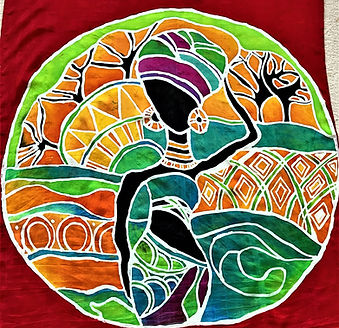
Tiya Dahyabhai
I have had a really lovely time learning how to batik with you all. Thank you for welcoming me! Here is my description:
Despite my family coming from an array of locations such as Gujarat, Tanzania and Kenya, to eventually Manchester and Birmingham, I was born and raised in Luton. I lived there for 18 years, and moved to London to pursue my interest in textiles. Quickly adjusting to London’s complex public transport system, I travelled on it every day to attend university, visit museums, and catch-up with friends. It was, and still is, central to my life in the city. In the mid 20th century, several designs of female textile artists were used as the woven upholstery material on various seats within London’s transport network. Influenced by their designs, my batik takes inspiration from their patterns which once decorated the city.
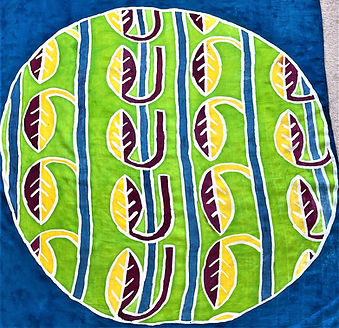
Indian embroidery influence
Rashmiben Patel
‘My journey has spanned over all three continents and I feel enriched by these journeys as I have been able to imbibe so many cultural influences in my life. I take inspiration from different things in different countries. Born in Kenya, I have been influenced by Kenyan food, culture, art, heritage. In 1959, my family emigrated to India which has influenced me immensely. I have grown very fond of Gujarati art, craft, embroidery, festivals, dance, music and literature . My piece draws inspiration from the Gujarati craft of embroidery and mural art called Lippan Art. ! The circles in my batik piece remind me of mirror work embroidery and lippan work which one sees in the Kutch bunga huts.
I have a good collection of colourful Garba attires, handicrafts bearing gorgeous and exquisite embroideries. Everytime I wear these outfits, I think of the artisans in Gujarat who would have made these. Working on this batik project, I have appreciated the hard work which these artisans put in and create such beautiful garments. I never realised that batik work requires so much skill and patience !
It has been a wonderful experience and I would love to learn more. I am so happy that I got an opportunity to learn about batik painting in England! I came to this country in 1971. Such is the beauty of our journeys where we mingle with new people, make new friends and seek new opportunities!

Maiuri Chanderia
Thank you Subrang for going us a platform to participate.
This is my batik story.
When I first heard the brief of telling the migration story through batik paintings, I was immediately drawn towards a peacock, not only because it's my namesake but also because of what the peacock represents to me.
I have many sarees, including my wedding saree and jewellery in peacock designs and wearing them always uplifts me.
My peacock journey is linked by it being the national bird of India where my parents were born and also represents "rebirth" in Christianity and therefore a part of Africa as I was born in Kenya and in Europe as I have lived in England since 1972.
To me the peacock represents a beauty that crosses culture and diversity
which our migration has allowed us to do.
Let us all stand tall and be proud of who we are, all that we have overcome and continue to make a difference. Let us be loud and proud as the peacock and change the myth that the peacock is vain...it's not vain but just belives in itself

Nayna Chhatralia
The inspiration for my piece comes from the elephant headed Hindu God of beginnings – Lord Ganesh. He is the remover of all obstacles. Participating in these batik workshop has been one of the most inspiring experience and I have felt the positive energy from all participants. In my mind, I feel Lord Ganesh is looking down upon us. When I left the shores of India, I was given an idol of Ganesh as a keepsake and to this day, I have it in my house after so many years and I worship him everyday. Settling in a foreign country has not been very easy but the strength and confidence Ganesh gives me is pricelss. I want to frame this batik piece which will remind me of all the positive energy which has flown throughout the project.

Pinki Patel
My journey began in London where I was born. My parents decided to go back to India when our father became quite ill. But there he found difficulty in getting a work in his field as a pharmacist. He had heard that life was good in East Africa, so the family moved to Nairobi, where I have a very fond childhood memories. Eventually we came back to the UK as he believed that it was the best place for education. We travelled the three continents in under 9 years!
I choose the peacock as it is the national bird of India. I think it is the most beautiful and elegant bird and is vibrant just like India and its people.
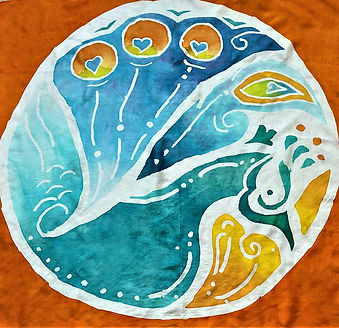
Pinki Patel
My second piece is of a family of giraffes. I have always admired the way they move so elegantly and they show us the importance of a tight knit family.
If given the opportunity I would love to complete my journey with a batik representing my life in the UK.
I love different types of crafts and am thankful that I was given the opportunity to do batik with such dedicated people who were so helpful in assisting us in producing our pieces.
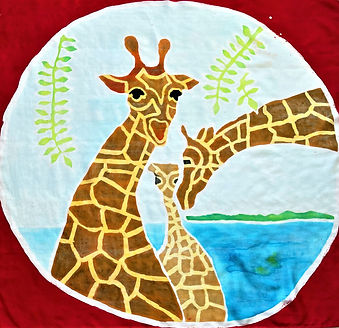
Diwali memories
Jyoti Patel
I have very fond memories of my childhood in Kenya where I was born. Even though we were miles away from India, my parents used to celebrate Diwali with lot of fanfare and the festivities would go on for days. My mother taught me the lovely art of Rangoli and my piece draws inspiration from these rangoli patterns taught by her. Even though I have emigrated to UK, it seems like I have never missed the festivities of Diwali, because here in England too, we celebrate Diwali with equal fanfare. I see Rangoli patterns drawn at weddings too. This inspires me to stay connected with my heritage. Migration might have taken me away from my roots but I feel so happy that I am able to celebrate it in my adopted country too. The vibrant colours give me lot of joy and happiness

African village
Hina Amin
I have always made it a point of duty to leave myself open to the discovery of new things and to always strive to do something new everyday. Thus when I came across the batik workshops, I was fascinated by the idea and wanted to explore my creative thought process. I would like to share the inspiration behind my meaningful piece. Batik painting on silk has provided me with reflective moments.
The tranquility of an African village is remarkable. There is something eternally graceful about seeing a women carrying a pot on her head. A vision of feminity, balance and sustenance with their gait being slow and gentle and their posture, dictated by maintenance of their load, remaining perfect.
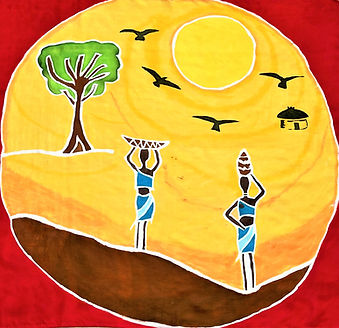
African folk art
Lata Desai
Growing up in Africa, I was deeply influenced by African folk art. I remember playing with my maid’s children in the garden who introduced me to the world of art by simple geometric patterns of dots, circles, zigzags, diamonds, triangles, lozenges, squares, curved lines, waves, spirals
At that age, I did not realise the meaning of these patterns but later understood how meaningful they were and each design represents the artistic expression of African culture. I love the idea of each pattern conveying a specific message to the wearer, commemorating their heritage and beauty of their motherland.

Jigisha Patel
Bird of paradise flower is one of my favourite flower, as it symbolises paradise, freedom, joy and excitement. It’s magnificence captivates me and encourages me to express myself with confidence. It is a constant source of inspiration to me. When I emigrated to England from India, I first saw this beautiful flower in Kew Gardens and it has inspired me so much over the years giving me hope for the future .

Kalpana Vashee
I was born and brought up in Rhodesia, now Zimbabwe. My grandparents had migrated from Gujarat, India in 1940. Growing up, I was always a studious student and loved mathematics. I had never explored my artistic or creative talent..... I didn't think I had any!! I didn't expect to enjoy the Batik workshops so much. I loved playing with the paint colours and brining to life my elephant. I have travelled to India too and noticed the difference between the elephants in Africa and India.. It was very therapeutic .I am grateful for the opportunity, thank you.

Navratri and Goddess Durga
Bhavna Patel
Growing up in India, I was influenced by all kinds of festivals but my favourite festival is Navratri – the Festival of nine nights where there is colorful melange of religious rituals and endless rounds of cultural dance and music .
As a dancer, I love the celebration of Navratri and I take lot of inspiration from Goddess Durga who is the epitome of power. She teaches us to have faith in ourselves and believe in our inner strength. The trishul is a trident, a divine symbol which represents holiness and good deeds and is said to remove the troubles of past, present and future.
My batik piece is inspired by her.
I have never had any training in batik work, but whilst preparing this piece, I started believing in myself and I got the inner strength to produce a beautiful piece of art which will adorn my house forever.
When I came to Britain, I did not at all feel that I was away from my motherland. Wherever Gujaratis go, they take a piece of Gujarat with them. Every year, I dance during all the nine nights of Navratri and Goddess Durga gives me lot of inspiration.
My journey from India to England has been further enriched by SUBRANG ARTS who keeps on creating wonderful opportunities for me - whether it is performing arts or visual arts. I feel blessed that even though I am living in London, I am able to keep on learning about my rich cultural heritage.
Thank you

Kalpana Patel
Thank you Subrang for the wonderful batik workshop. I throughly enjoyed it.
A beautiful gift from nature, flowers never fail to amaze me. They have the power to bring a smile to all faces, with their array of shapes, fragrances and colours.
I have travelled to some countries around the world, and during these visits I have been able to encounter a vast range of enchanting flora and fauna. It was on one such trip that I was captivated by the electric blue and neon orange of one of my favourite flowers: the bird of paradise. A flower native to South Africa, it really does resemble one of the stunning birds in mid-flight!
The dazzling plant inspired my batik design. I feel blessed to share a planet with such a beautiful nature and I can’t imagine a world without flowers!
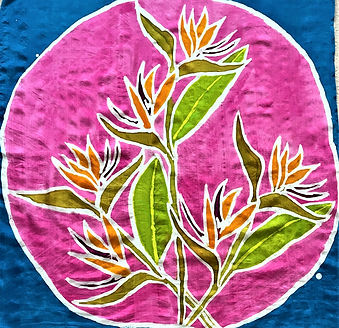
Om
Riti Desai
My heartfelt thanks to Lataben and Sabrang arts for giving me the opportunity to be part of this creative journey.
I am born and brought up in Mumbai , India and came to UK in the late 90’s.
I have always had a passion for art, craft and textiles and occasionally pursue it. COVID has made me refocus on it.
My piece is based on the concept of Mandala- a geometric configuration of symbols. In various spiritual traditions, mandalas are used as spiritual guidance tools. I have focused on the symbol of ‘AUM’. It signifies the core of consciousness and reality. It is one universal symbol which spreads across diverse cultures and is integrated both in Indian and western cultures.
Some of the geometric shapes I have used are also an inspiration from the ‘Kutchi/ Aari Bharat’ Embroidery , which is a handicraft and textile signature art tradition of the tribal community of Kutch District , Gujarat, India.

The Indian Dancer
Sheena Patel
My second piece depicts my cultural heritage and the colours that stem from it.
India is flooded with colour. The vibrant saris softly flutter on the sandy pathways. Temples are decorated with marigolds in vibrant orange hues and market lanes are lined with stores selling multihued spices. Colour is everywhere!
My intention was to showcase how I integrate into colour, through festivals, weddings and rituals. It highlights how I have embraced my identity whilst being part of a modern British society,
It is a gentle reminder to stay true to myself and true to my roots.
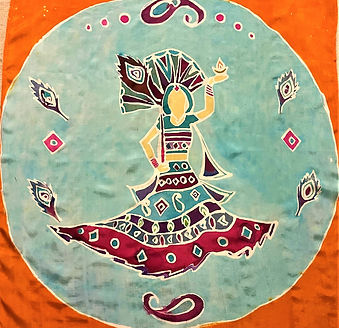
Bandhani effect
Nayna Chhatralia
My hometown Rajkot is famous for its Bandhani fabrics. Tie and dye is a common practice which is involved in the arts of Rajkot. A plain piece of cloth is tied with threads and dyed with various colours. It gives me great pride that my home town produces some of the best bandhani textiles. I wanted to try Batik technique to create a piece of scarf with Bandhani influences. I have a wardrobe full of all kinds of Bandhani sarees and this batik printed scarf will be another priced addition to my collection as I have thoroughly enjoyed this project. I feel great sense of achievement that I have learnt a new skill at my age and I look forward to learning new skills in the future. My journey to England has opened up so many opportunities and this kind of batik workshop is a classic example! I live in London but I have never forgotten my roots and I draw inspiration from all art forms of my motherland.






